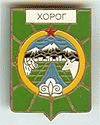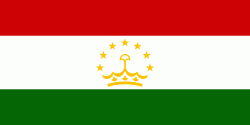Khorugh
 |
Khorugh is 2200 m above sea level in the Pamir Mountains (ancient Mount Imeon) at the confluence of the rivers Ghunt and Panj. The city is bounded to the south (Nivodak) and to the north (Tem) by the deltas of the Shakhdara and Ghunt, respectively. The two rivers merge in the eastern part of the city flow through the city, dividing it almost evenly until its delta in the Panj, on the border with Afghanistan. Khorugh is known for its poplar trees that dominate the flora of the city.
Until the late 19th century, Khorugh was in an area disputed between the Emir of Bukhara, Shah of Afghanistan, Russia and Britain. The Russians emerged the winners of the region after The Great Game, which fixed the current northern border of Afghanistan on the Panj River and established the territory of Russian Pamir around Khorugh.
Before 1896, when the Russians arrived and built a fort, the main town in the area was Kala-i Bar Panj (or Bar Panja Qal'a) somewhat downriver on the Afghan side. Following the fall of czarist Russia and the rise of the Soviet Union, Khorugh became the capital of Gorno-Badakhshan in 1925. Soviet leaders encouraged the migration of settlers to the area with promises of pay, medals and automobiles, but with no industry and little arable land, the effort was not successful.
Khorugh occupied headlines in July 2012 due to a government forces clash with guerrillas. Over 40 people, including 12 soldiers were killed (many reports indicated that the number of casualties could be higher). The country’s security forces moved in to arrest suspects in the murder of secret services General Abdullo Nazarov. The alleged criminals were linked to former guerrilla leader-turned-border patrol commander Tolib Ayombekov. Ayombekov is alleged to have been involved in drug trafficking and the smuggling of tobacco and precious stones for many years. In 2014, 2018, 2021 and most recently in May 2022, Khorugh was the scene of violent clashes and demonstrations against suspected human rights violations by security forces.
Pamir's botanical garden is the most popular view of Khorog. It was established in 1940 to test the survival rate of various plants in mountain climate conditions. More than 30,000 varieties of plants have been checked according to official statistics, which now covers around 4,000 types of garden collection. Located close to Khorog, the botanic garden of Pamir opens up a great panoramic view of the entire city.
Map - Khorugh
Map
Country - Tajikistan
 |
 |
| Flag of Tajikistan | |
The territory that now constitutes Tajikistan was previously home to several ancient cultures, including the city of Sarazm of the Neolithic and the Bronze Age and was later home to kingdoms ruled by people of different faiths and cultures, including the Oxus civilization, Andronovo culture, Buddhism, Nestorian Christianity, Hinduism, Zoroastrianism, Manichaeism, and Islam. The area has been ruled by numerous empires and dynasties, including the Achaemenid Empire, Sasanian Empire, Hephthalite Empire, Samanid Empire, and Mongol Empire. After being ruled by the Timurid Empire and Khanate of Bukhara, the Timurid Renaissance flourished. The region was later conquered by the Russian Empire and subsequently by the Soviet Union. Within the Soviet Union, the country's modern borders were drawn when it was part of Uzbekistan as an autonomous republic before becoming a full-fledged Soviet republic in 1929.
Currency / Language
| ISO | Currency | Symbol | Significant figures |
|---|---|---|---|
| TJS | Tajikistani somoni | ЅМ | 2 |
| ISO | Language |
|---|---|
| RU | Russian language |
| TG | Tajik language |















